Next: Review and Summary Up: Chapter 1: Basic Quantities Previous: Energy Sources
It is often needed to concatenate two circuits in series (cascade), by connecting the output port of the first circuit, considered as the source, to the input port of the second circuit, considered as the load. Here are some examples:
In general, an active circuit containing active components
(e.g., transistors and operational amplifiers) as well as
passive components (e.g., 










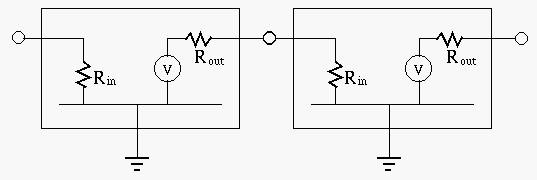
Consider the following three examples:
The output resistance 

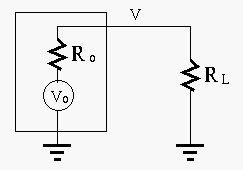
For the load to receive maximize voltage, we want
 of the source
circuit to be as small as possible, so that little voltage drop
across it will be caused when the load circuit draws a large curren
from the source even if its input (load) resistance
of the source
circuit to be as small as possible, so that little voltage drop
across it will be caused when the load circuit draws a large curren
from the source even if its input (load) resistance
 is
small.
is
small.
 of the load circuit to
be as large as possible, so that it draws little current from the
source, causing small internal voltage drop across its output
resistance
of the load circuit to
be as large as possible, so that it draws little current from the
source, causing small internal voltage drop across its output
resistance
 , even if it is large.
, even if it is large.
Some times we need to maximize the power (instead of the voltage)
delivered from the source to the load. For example, the power
amplifier of a stereo system needs to deliver high power to the
speakers as the load. Given the internal resistance


 |
(118) |
 , we can minimize
, we can minimize  to maximize the delivered
power
to maximize the delivered
power  :
:
 |
(119) |
 , we need to find the optimal value
for
, we need to find the optimal value
for  to maximize
to maximize  , by solving the following equation:
, by solving the following equation:
 |
(120) |
 is equal to the internal resistance
is equal to the internal resistance  ,
will it receive maximum power.
,
will it receive maximum power.
The maximum power received by 
 |
(121) |
 |
(122) |
 is
is
 |
(123) |
 consumes the same amount of power
as the load
consumes the same amount of power
as the load  . The figure below shows the power
. The figure below shows the power  consumed
by the load resistor
consumed
by the load resistor  when
when  . We see that if
. We see that if  is
either smaller than or greater than
is
either smaller than or greater than  ,
,  is reduced.
is reduced.
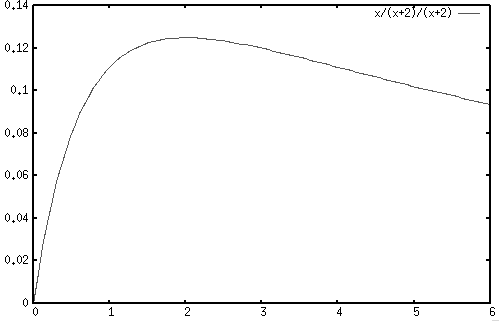
The efficiency of the circuit is defined as the ratio of the power
delivered to the load 

 |
(124) |
 and the load receives maximal power, but the efficiency
is only
and the load receives maximal power, but the efficiency
is only  . We can improve the efficiency by increasing
. We can improve the efficiency by increasing  so
that
so
that  approaches 1 when
approaches 1 when
 . But in this case the
power received by the load is reduced.
. But in this case the
power received by the load is reduced.
For example, if 
 |
(125) |
 |
(126) |
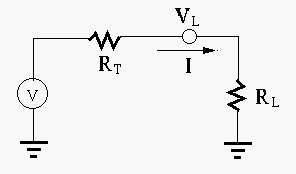
A power transmission line delivers power from power generation (a power plant) to power consumption (e.g., a city). The concern is no longer delivering maximum power (as long as needed power is delivered), but to achieve maximum efficiency in the sense that the power loss along the power transmission line is minimized.
We denote the resistance of the transmission line by 


 :
:
 i.e. i.e. |
(127) |
 :
:
 |
(128) |
 is fixed (already minimized) and
the power consumption
is fixed (already minimized) and
the power consumption  is to be guaranteed, to minimize the power
loss
is to be guaranteed, to minimize the power
loss  along the transmission line we can only increase the voltage
along the transmission line we can only increase the voltage
 . For example, when the voltage is increased 10 times, the power
loss will be reduced to 1/100. In practice, the voltage
. For example, when the voltage is increased 10 times, the power
loss will be reduced to 1/100. In practice, the voltage  can be
as high as a few hundred
can be
as high as a few hundred  (69 kV, 115 kV, 230 kV, 500 kV, 765 kV).
(69 kV, 115 kV, 230 kV, 500 kV, 765 kV).
Summary: The circuits in the three examples above are essentially
the same, i.e., they all have a voltage source 



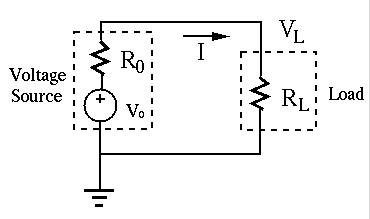
 , maximize input resistance
, maximize input resistance  .
.
 of total power):
match the output and input resistances
of total power):
match the output and input resistances 
 .
.